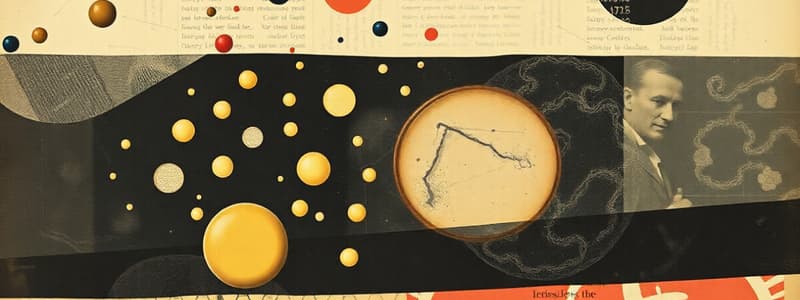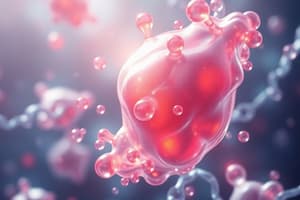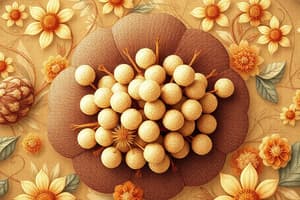Podcast
Questions and Answers
Which statement accurately describes the relationship between fatty acids and lipids?
Which statement accurately describes the relationship between fatty acids and lipids?
- Fatty acids are formed during the digestion of lipids in the stomach.
- Fatty acids and lipids are unrelated molecules that serve different functions.
- Fatty acids transport lipids through the bloodstream.
- Fatty acids are the building blocks or precursors for more complex lipids. (correct)
What structural feature distinguishes saturated from unsaturated fatty acids?
What structural feature distinguishes saturated from unsaturated fatty acids?
- Unsaturated fatty acids have one or more carbon-carbon double bonds. (correct)
- Saturated fatty acids contain an even number of carbon atoms.
- Saturated fatty acids are always arranged in a _cis_ configuration.
- Unsaturated fatty acids are typically found in animal fats.
Which type of fatty acid is most likely to contribute to the development of atherosclerosis due to its ability to pack tightly and accumulate in arteries?
Which type of fatty acid is most likely to contribute to the development of atherosclerosis due to its ability to pack tightly and accumulate in arteries?
- Monounsaturated fatty acids
- Polyunsaturated fatty acids
- Omega-3 fatty acids
- Saturated fatty acids (correct)
What is the primary industrial purpose of hydrogenating unsaturated fats?
What is the primary industrial purpose of hydrogenating unsaturated fats?
A food product label indicates the presence of 'partially hydrogenated oil'. What type of fatty acid is most likely present in this product as a result of this process?
A food product label indicates the presence of 'partially hydrogenated oil'. What type of fatty acid is most likely present in this product as a result of this process?
How does the structure of trans fats differ from that of cis fats, and what is the health implication of this difference?
How does the structure of trans fats differ from that of cis fats, and what is the health implication of this difference?
What is the defining characteristic of a triglyceride molecule?
What is the defining characteristic of a triglyceride molecule?
Why are triglycerides considered hydrophobic molecules?
Why are triglycerides considered hydrophobic molecules?
Where does the majority of fat digestion occur, and which enzyme plays a key role in this process?
Where does the majority of fat digestion occur, and which enzyme plays a key role in this process?
What is the role of phospholipids in cell membranes?
What is the role of phospholipids in cell membranes?
Which of the following is a key function of cholesterol in the body?
Which of the following is a key function of cholesterol in the body?
What is atherosclerosis, and what is its primary cause?
What is atherosclerosis, and what is its primary cause?
What is the key difference between visceral fat and subcutaneous fat in terms of location and metabolic impact?
What is the key difference between visceral fat and subcutaneous fat in terms of location and metabolic impact?
Based on current dietary recommendations, what is a general guideline regarding fat intake for maintaining health?
Based on current dietary recommendations, what is a general guideline regarding fat intake for maintaining health?
Fatty acids always have which structure?
Fatty acids always have which structure?
A fatty acid consists of a long chain of carbon atoms linked together by what?
A fatty acid consists of a long chain of carbon atoms linked together by what?
Which of the following is true about saturated fats?
Which of the following is true about saturated fats?
Which of the following is true of unsaturated fats
Which of the following is true of unsaturated fats
Which of the following is true about saturated fatty acids?
Which of the following is true about saturated fatty acids?
What does Hydrogenation of Fats do?
What does Hydrogenation of Fats do?
What is a monoglyceride?
What is a monoglyceride?
What is the result of hydrolysis?
What is the result of hydrolysis?
In upper body subcutaneous fat, cells increase in what?
In upper body subcutaneous fat, cells increase in what?
What is the daily recommended grams for men of saturated fat per dat?
What is the daily recommended grams for men of saturated fat per dat?
Which of the following is a function of triglycerides?
Which of the following is a function of triglycerides?
Trans fats are produced during hydrogenation as?
Trans fats are produced during hydrogenation as?
Where does most fat digestion take place?
Where does most fat digestion take place?
Which of the following is an effect of trans fats?
Which of the following is an effect of trans fats?
Which of the following describes Atherosclerosis
Which of the following describes Atherosclerosis
What happens to fats when digested?
What happens to fats when digested?
Which of the following can be a source of trans fats?
Which of the following can be a source of trans fats?
Atherosclerosis is a disease in which what blood part builds up inside your arteries?
Atherosclerosis is a disease in which what blood part builds up inside your arteries?
Trans fats are unhealthy because?
Trans fats are unhealthy because?
Flashcards
What are lipids?
What are lipids?
A diverse group of molecules, including fatty acids, triglycerides, phospholipids, sterols, and fat-soluble vitamins.
What are fatty acids?
What are fatty acids?
The basic units of lipids, consisting of a carboxyl group attached to a hydrocarbon chain.
What connects fatty acids?
What connects fatty acids?
Fatty acids linked by covalent bonds.
What are saturated fats?
What are saturated fats?
Signup and view all the flashcards
What are unsaturated fats?
What are unsaturated fats?
Signup and view all the flashcards
What is hydrogenation?
What is hydrogenation?
Signup and view all the flashcards
What are Cis fats?
What are Cis fats?
Signup and view all the flashcards
What are trans fats?
What are trans fats?
Signup and view all the flashcards
What are triglycerides?
What are triglycerides?
Signup and view all the flashcards
What is pancreatic lipase?
What is pancreatic lipase?
Signup and view all the flashcards
What results from triglyceride breakdown?
What results from triglyceride breakdown?
Signup and view all the flashcards
What are phospholipids?
What are phospholipids?
Signup and view all the flashcards
What is cholesterol?
What is cholesterol?
Signup and view all the flashcards
What is atherosclerosis?
What is atherosclerosis?
Signup and view all the flashcards
What is visceral fat?
What is visceral fat?
Signup and view all the flashcards
What is subcutaneous fat?
What is subcutaneous fat?
Signup and view all the flashcards
Study Notes
Fundamentals of Science - Level 6 Certificate in Food Science and Technology
- Session 2 covers nucleic acid structure, lipids and glucose, carbohydrates, and homeostasis.
- Learning objectives include nucleic acid structure and function definition, lipids and carbohydrates descriptions, and impact of proteins, carbohydrates and lipids as part of nutrition
Module Contents
- Biology includes Cell Structure and Function, Proteins and Analysis, Nucleic Acids, Lipids, Carbohydrates, Nutrition, Enzymes, Quantitative Analysis, Spectro & Lambda Max, and Weights, Measures, and Preparation.
- Chemistry includes Periodic Table, Chemical Bonds, Acids and Bases, and Elemental Analysis.
Function of Lipids
- Fats are biomolecules
- Involved in Cholesterol and Fats and Obesity
- Consists of Fatty Acids with subdivisions Saturated vs unsaturated fatty acids, hydrogenation, cis and trans fats.
- Also includes Triglycerides – structure and the diet and Fats and the cells - Phospholipids.
- Lipids are a diverse group of molecules.
- Fatty acids are precursors for more complex lipids
- Triglycerides act as a storage form of fat energy
- Phospholipids are found in cell membranes to create a barrier for the cell and control the flow of material
- Sterols consist of cholesterol and steroids
- Fat soluble vitamins are A, D, E, and K.
Basic Units of Lipids
- Fatty acids have a carboxyl group and a hydrocarbon chain
- Chain can vary, leading to different types of fatty acids, they consist of a long chain of carbon atoms linked together by covalent bonds (sharing)
- Fatty Acids: The number of carbon atoms will always be even
- Contains carbon atoms most commonly C16 and C18
- Is uncommon to contain less than 14 and more than 20
- Saturated fats contain No Carbon double bonds
- Unsaturated fats have 1 or more Carbon double bonds.
- Monounsaturated will contain a 1 Carbon double bond
- Polyunsaturated will contain >2 Carbon double bond
Saturated vs Unsaturated
- Saturated fatty acids are animal products
- Saturated fats storage is solid at room temperature
- Unsaturated fatty acids are from plant products
- Unsaturated fats storage is liquid at room temperature
- Atherosclerosis is the clogging of arteries due to saturated fatty acids
- Due to the double bonds of polyunsaturated fats, they do not pack well due to their irregular shape
Unsaturated fats: Cis and Trans Fats
- Cis fats are the typical form of unsaturated fats
- Contains C=C double bonds
- These bonds can come in two forms, namely cis and trans
Hydrogenation of Fats
- Unsaturated fats that are altered by reaction with hydrogen (in presence of a catalyst)
- Result is that it breaks all the double bonds and is now fully saturated
- Vegetable oils used to produce saturated fats (solid)
- Process is completed in industry due to more desirable physical properties
- Melts at a desirable temperature (30–40 °C)
- Involves long storage time
- This is opposite to polyunsaturated oils (rancid when reacted with O2 in air)
- Trans fats are considered bad
- Cis fats are considered good - unsaturated
- Trans fats are unhealthy because the enzymes responsible for metabolising them are expecting 'cis fats' which disrupts the metabolic chain
- Trans fats occur as products created during hydrogenation as contaminants, created by an unwanted side reaction
- Trans fats are a by product of partial hydrogenation
- Partial hydrogenation increases the risk of coronary heart disease
- Trans fats sources include common commercial baked foods, microwave popcorn, and fried foods
- Trans fats have been mitigated by banning by the FDA (US)
Triglycerides
- Formed when a glycerol molecule reacts with three fatty acid molecules
- Main function is in energy storage, either fat or oil form
- A neutral Fat Molecule is nonpolar and uncharged
- Has hydrophobic properties that dislike water
- Insoluble, but soluble, in organic solvent
- Glycerol is an alcohol that contains 3 carbons that are all attached to OH (hydroxyl group).
- Together, a reaction between COOH (fatty acid) and OH from the glycerol
- The reaction results in the removal of a water molecule
- This removal process forms an ester bond
- In the body, glycerol reacts with three fatty acids through ester linkages to form triglycerides.
- Triglycerides are naturally found in food
- In the body, saturated fats can be found in animal products in solid form
- Unsaturated fats can be found in plants as liquid form
Function of triglycerides
- Provides cellular energy for the body
- Stored inside fat droplets in the adipose tissues as fuel storage for use during starvation
- Fatty tissue provides protection from trauma to organs and provides insulation to maintain body temperature.
Fats in the diet
- A small amount of fat is good for you
- Too much saturated fat can increase your risk of developing circulatory diseases
- Replacing the saturated fat with unsaturated fact helps keep your heart healthy and manage your weight
- 1g fat = 9kcal
Digestion of fats
- Most fat digestion takes place in the small intestine via pancreatic enzymes and bile salts
- Pancreatic lipase acts as the main enzyme in triglyceride hydrolysis
- Hydrolysis results in breaking triglyceride into monoglycerols and free fatty acids
- Fats are then absorbed by enterocytes
Role of fats in the Cell
- Phospholipids are another lipids with a hydrophilic head containing a phosphate group and a hydrophobic tail from fatty acids
- Phospholipids are lipids with a lipid bilayer membrane
- This basic cellular structure acts as a barrier to protect the cell.
Cholesterol
- A lipid made by the body
- Can be found in every body cell
- Cholesterol forms a key component of the plasma membrane which helps stabilize membrane structure against temperature effects
- The body needs cholesterol for hormones, it acts as a precursor to steroid hormones with the like of testosterone, estrogen, progesterone and cortisol
- Provitamin D is a derivative of cholesterol, it is converted to vitamin D in the skin by UV light
Atherosclerosis
- A disease in which plaque builds up inside your arteries
- Arteries are blood vessels that carry oxygen-rich blood to your heart and other parts of your body
- Plaque is made up of fat, cholesterol, calcium and other substances found in the blood
- Over time, plaque hardens and narrows your arteries
- Limits the flow of oxygen rich blood to your organs and other parts of your body
- Arthrosclerosis can lead to serious problems, including heart attack, stroke or even death
Links between fat and obesity
- Obesity occurs when extra calories are stored in the body as fat
- Fat cells, or adipocytes, expand in number and size filing with trigyclercides
- Obesity is associated with visceral fat, often called 'belly fat'
- The recommended daily allowance for men 30g of saturated fat per day and for women 20g of saturated fat per day
Location of fatty tissue
- Location of fatty tissue determines its metabolic profile
- Visceral fat is located underneath the abdominal wall and around the heart, lungs, kidneys, and below the abdominal muscle
- Recently discovered to be a significant producer of signaling chemicals (hormone)
- Involves other hormones that are involved in inflammatory responses, linked to obesity and Type 2 diabetes
- Sub-cutaneous fat is located beneath the skin but not around the vital organs, keeps us warm and provides padding so protects from injury
Summary of Lipids
- Different types of fats include Saturated, monounsaturated and polyunsaturated.
- Includes Saturated and unsaturated sources.
- Role of trans fats with benefits of a low fat diet/ fat in the diet
- Know Recommended daily allowance
Revision Questions:
- What are the two types of unsaturated fats?
- What is the process of hydrogenation and what is its application in industry?
- What are trans fats?
- What are the functions of fats?
- What is the structure of a triglycerides?
- How are lipids digested?
- What is atherosclerosis?
- What is the difference between visceral and subcutaneous fats?
- What is the role of fat in obesity and how can it be monitored to prevent?
Studying That Suits You
Use AI to generate personalized quizzes and flashcards to suit your learning preferences.




